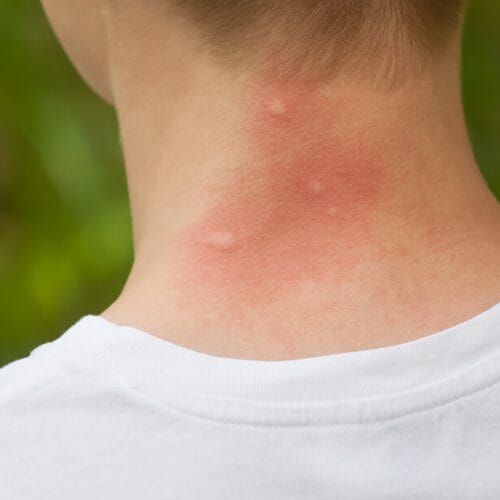
Every year mosquitos kill more than one million people. Yes, you read that right. Mosquitos are actually considered the deadliest animal on the planet. According to the World Health Organization, the majority of deaths caused by mosquitos result from malaria.
The organization also estimates that between 300 and 500 million cases of malaria occur each year — and a child dies from malaria every 30 seconds. But mosquito bites aren’t the only thing you should worry about throughout the year. Whether you are camping in the great outdoors or just going outside for a walk, bug bites can happen in any location. Here is everything you need to know about bug bites and a few tips for minimizing your risk.
RECENT NEWS ABOUT INSECT BITES
According to the latest Center for Disease Control (CDC) figures, the number of vector-borne diseases transmitted by bug bites has more than tripled between 2004 and 2016. Reported cases surged from 27,388 to nearly 100,000 annually for a total of 642,602 cases. What is even more shocking is that the CDC estimates that those numbers are actually dramatically higher due to many cases going unreported.
Not only is the spread of disease alarming, but bug bites are now spreading more germs than ever before. Doctors and scientists have discovered nine new bacteria spread by mosquitoes and ticks in the United States and its territories since 2004. These diseases include the Bourbon virus, a rare and deadly tick-borne disease first spotted in Bourbon County, Kansas, in 2014. Another disease recently discovered is the Heartland virus, which spreads through lone star ticks found in Midwestern and Southern states.
OTHER INSECT BITE BASICS
MOSQUITO BITES
By far the deadliest insect on the planet, mosquitos are found throughout the United States. While malaria doesn’t affect America as much as countries like Sub-Saharan Africa or Indonesia, a variety of mosquitos live in America. Most notably, mosquitos found the United States can carry dengue and yellow fevers, encephalitis, elephantiasis, and canine heartworm, as well as, West Nile virus and Zika. These diseases can cause permanent disability, illness, or even death.
One of the most talked-about mosquito-transmitted diseases, Zika, has been linked to severe birth defects. While Zika isn’t prevalent in the United States, many American travelers have contradicted the conditions while on vacation. The congenital disabilities caused by this disease include microcephaly, which is an abnormally small head and brain size.
Another common disease spread by mosquitos is the West Nile virus. West Nile can cause severe illnesses that affect the nervous system, such as encephalitis and meningitis. Encephalitis causes swelling of the brain, and meningitis causes brain and spinal cord membrane inflammation.
TICKS AND TICK BITES
The number of vector-borne diseases transmitted by bug bits has most than tripled since 2004, according to the CDC. One of the most significant contributors is ticks. Tick-borne Lyme disease and anaplasmosis are prime examples. Approximately 30,000 cases of Lyme disease are reported each year, but that number could actually be ten times greater due to the difficulty of diagnosing the condition.
LYME DISEASE
Lyme disease is the most common vector-borne disease in the United States. The bacteria Borrelia burgdorferi causes the condition. In 2014, the Environmental Protection Agency (EPA) added Lyme disease to its list of climate change indicators as its rise coincides with changes in temperature and climate.
Hardy black-legged ticks that spread the Lyme-causing bacteria have taken up residence as far north as Canada and are now found in half of America (double the number from 1994).
Meanwhile, lone star ticks, natives to southern countries, have been spotted as far north as Maine. This tick variety transmits tularemia and human granulocytic anaplasmosis.
LYME DISEASE RASH
If you get bitten by a tick, the ticks may transmit Lyme disease pathogens into your skin. When this happens, an expanding circular red rash, often in the shape of a bull’s-eye, may appear within a week to 10 days of the bite.
If this rash appears, or if a tick bite leads to muscle aches, headaches, nausea, or any flu-like symptoms, see a doctor immediately. These are all signs of serious tick-borne illnesses, including Lyme, and antibiotic treatments can help stop the disease.
HOW TO AVOID BUG BITES AND MINIMIZE YOUR RISK

You can minimize your risk of getting bitten by a tick or mosquito by wearing insect repellant, having additional clothing coverage, and avoiding areas frequented by bugs. While it is hard to stay away from the outdoors, make sure to take care of yourself when you go outside. Wear bug repellent and long-sleeved clothing.
You should also check your body for ticks daily. Getting a tick off of your skin as soon as possible can greatly minimize your risk of contradicting a vector-borne disease. According to the CDC, if a tick is attached to your skin for less than 24 hours, your chance of getting Lyme disease is small.
If you get bitten, do your best to not scratch. Scratching or picking a bite can cause a secondary bacterial infection. Regardless of the type of bug bite, if you notice the skin around your bug bite becomes larger, redder, more painful, or more inflamed after a day or two has passed, you could have a bacterial infection. The same holds for muscle aches, chills, fever, or other systemic symptoms.
Talk with one of our medical professionals for additional help with your insect bites. You can also set up a same-day appointment for in-person guidance and assistance.

